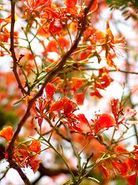Kindness is like water and religion is like tea. We can live without tea but not without water.
- Dalai Lama
I came to the USA over 41 years ago as a student, and thus have spent more than two-thirds of my life here. While I have maintained my connections with my roots through family, religion and culture, I also consider myself a patriot and true American, one who is proud of my citizenship. However, I have been disturbed as to the current civil discourse, not having seen such hurtful and hate-inciting actions in this arena before. Internet, texting, twitter-posting and other modes have become convenient tools for putting others down.
While this extends beyond politics, let’s start there. I have felt that Mr. Trump paints a dark picture of America, and *very* rarely shares good thoughts or kind words (though I was pleasantly surprised at his recent compliment to Hillary Clinton regarding her fighting nature in the second debate). Hillary Clinton’s secretive nature and perceived lying and “cold” demeanor has bred distrust.
To add to the mess, the media has changed the landscape of political news, trying to increase the drama factor. MSNBC, CNN and FOX are purveyors of different kinds of snake oils, and I find it disturbing the impact that the press can have on our public, without always being reliable. I lament the bygone days of Walter Cronkite, Peter Jennings, and Robert Mcneil, when you could hang your hat on the nightly news, but unfortunately our society needs more “entertainment.”
Anger and hate are infectious and they need to be guided with kindness, understanding and compassion. In the current political atmosphere, both sides are playing nefarious games which have the potential of unraveling the moral fabric of our beautiful country. We are not too far from doing the irreparable damage and completely losing the spirit of our founders.
Gandhi once said that if you have a bad government, then you deserve it. This is especially true in a democracy. Our government and leaders, to a large extent, reflect our collective thought process. If we look into the mirror of our collective thought process, we will see how coarse, judgmental, and disrespectful our language has become. We are enveloped by the fear of unknown of “others” to the extent that rational thinking has no seat. It is said that the illusion of knowledge is worse than ignorance. Our ignorance is further compounded by the media and campaign dances of smoke and mirrors.
I wonder how we managed to travel so far without realizing that we had lost our way. We have conveniently divided ourselves into enemy camps of Republicans and Democrats. Tribal affinity is so strong that each person belonging to his/her party is not willing to give up his/her prism. The vote along party lines in the past few elections has become a norm. These days, when a leader expresses that he/she is considering voting outside of their party, he/she gets twitter abuses and sometimes mortal threats. An empire rests on the shoulders of its leaders, who in turn are dependent on the citizens for navigational vision. We need to ask ourselves: is his the vision we want, a country divided along party lines, racial fault lines, economic lines? I have seen the results of this kind of poisonous brew in India. Indians are still internally fighting hate inspired battles which were started 1000 years ago. The partition of India has not cured the disease. Love and understanding requires work. Hate revolution is easy to start, and it may give the desired results to some people in power, but the country suffers for hundreds of years.
Sometimes when I reflect on the current situation, I am under a waking nightmarish vision and fear that we are slipping into a slow, simmering decay. The words that Chief Sealth (1855) uttered after his defeat reverberate in me:
Tribe follows tribe and nation follows nation, like the waves of the sea,
It is order of nations and regret is useless,
Your time of decay may be distant but it will surely come,
For even the white man whose God walked and talked with him
As friend with friend, cannot be exempt from common destiny,
We may be brothers afterall, we will see.
My optimism forces me to think that we will overcome the division and negativity that currently plagues our political and civil arenas. My hope is that even in the remainder of this campaign, respect will prevail. My hope is that whoever gets elected will not only heal the divide but show the world that we have not lost the virtues taught to us by our founding fathers and visionaries. In the meantime, let us start a civil discourse with the “other” person. Let us be kind in language. Somebody said that be kind to others for you may not know that they may be fighting graver battle than yours. Let us practice catching those unkind hurtful words in the throat before they escape. Let us brake the walls of tribalism and have a civil dialogue. In the spirit of universal brotherhood (an essential tenet the Sikh religion), I am leaving you with the following poem:
I sought my God, My God I could not see,
I sought my soul, My soul eluded me
I sought my brother, and found all three.
-Anonymous
- Dalai Lama
I came to the USA over 41 years ago as a student, and thus have spent more than two-thirds of my life here. While I have maintained my connections with my roots through family, religion and culture, I also consider myself a patriot and true American, one who is proud of my citizenship. However, I have been disturbed as to the current civil discourse, not having seen such hurtful and hate-inciting actions in this arena before. Internet, texting, twitter-posting and other modes have become convenient tools for putting others down.
While this extends beyond politics, let’s start there. I have felt that Mr. Trump paints a dark picture of America, and *very* rarely shares good thoughts or kind words (though I was pleasantly surprised at his recent compliment to Hillary Clinton regarding her fighting nature in the second debate). Hillary Clinton’s secretive nature and perceived lying and “cold” demeanor has bred distrust.
To add to the mess, the media has changed the landscape of political news, trying to increase the drama factor. MSNBC, CNN and FOX are purveyors of different kinds of snake oils, and I find it disturbing the impact that the press can have on our public, without always being reliable. I lament the bygone days of Walter Cronkite, Peter Jennings, and Robert Mcneil, when you could hang your hat on the nightly news, but unfortunately our society needs more “entertainment.”
Anger and hate are infectious and they need to be guided with kindness, understanding and compassion. In the current political atmosphere, both sides are playing nefarious games which have the potential of unraveling the moral fabric of our beautiful country. We are not too far from doing the irreparable damage and completely losing the spirit of our founders.
Gandhi once said that if you have a bad government, then you deserve it. This is especially true in a democracy. Our government and leaders, to a large extent, reflect our collective thought process. If we look into the mirror of our collective thought process, we will see how coarse, judgmental, and disrespectful our language has become. We are enveloped by the fear of unknown of “others” to the extent that rational thinking has no seat. It is said that the illusion of knowledge is worse than ignorance. Our ignorance is further compounded by the media and campaign dances of smoke and mirrors.
I wonder how we managed to travel so far without realizing that we had lost our way. We have conveniently divided ourselves into enemy camps of Republicans and Democrats. Tribal affinity is so strong that each person belonging to his/her party is not willing to give up his/her prism. The vote along party lines in the past few elections has become a norm. These days, when a leader expresses that he/she is considering voting outside of their party, he/she gets twitter abuses and sometimes mortal threats. An empire rests on the shoulders of its leaders, who in turn are dependent on the citizens for navigational vision. We need to ask ourselves: is his the vision we want, a country divided along party lines, racial fault lines, economic lines? I have seen the results of this kind of poisonous brew in India. Indians are still internally fighting hate inspired battles which were started 1000 years ago. The partition of India has not cured the disease. Love and understanding requires work. Hate revolution is easy to start, and it may give the desired results to some people in power, but the country suffers for hundreds of years.
Sometimes when I reflect on the current situation, I am under a waking nightmarish vision and fear that we are slipping into a slow, simmering decay. The words that Chief Sealth (1855) uttered after his defeat reverberate in me:
Tribe follows tribe and nation follows nation, like the waves of the sea,
It is order of nations and regret is useless,
Your time of decay may be distant but it will surely come,
For even the white man whose God walked and talked with him
As friend with friend, cannot be exempt from common destiny,
We may be brothers afterall, we will see.
My optimism forces me to think that we will overcome the division and negativity that currently plagues our political and civil arenas. My hope is that even in the remainder of this campaign, respect will prevail. My hope is that whoever gets elected will not only heal the divide but show the world that we have not lost the virtues taught to us by our founding fathers and visionaries. In the meantime, let us start a civil discourse with the “other” person. Let us be kind in language. Somebody said that be kind to others for you may not know that they may be fighting graver battle than yours. Let us practice catching those unkind hurtful words in the throat before they escape. Let us brake the walls of tribalism and have a civil dialogue. In the spirit of universal brotherhood (an essential tenet the Sikh religion), I am leaving you with the following poem:
I sought my God, My God I could not see,
I sought my soul, My soul eluded me
I sought my brother, and found all three.
-Anonymous



 RSS Feed
RSS Feed